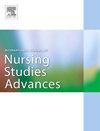Knowledge mapping of burnout among nursing professionals: A bibliometric study
IF 3.1
Q1 NURSING
International Journal of Nursing Studies Advances
Pub Date : 2025-09-25
DOI:10.1016/j.ijnsa.2025.100427
引用次数: 0
Abstract
Background
Occupational burnout is defined as a state of physical and mental exhaustion resulting from prolonged exposure to work-related stress, which is particularly evident among healthcare workers. With the changing global health situation, nurses are experiencing increased work pressures, leading to a growing incidence of occupational burnout. This affects not only the physical and mental well-being of nurses but also the quality of nursing care provided. Therefore, research on occupational burnout among nurses is of great significance. Our objective was to review systematically the current research status, identify key hotspots, and analyze trends in this field through bibliometric analysis, thereby offering a reference for future research.
Methods
In this study, literature related to occupational burnout among nurses published between January 2004 and April 2024 in the Web of Science database was retrieved. For trend comparisons, 2024 publication volume was annualized by multiplying Jan-Apr counts by 3. A total of 977 articles were included for analysis. Tools such as the "bibliometrix" package in R software, Citespace 6.3.R1, and VOSviewer were used to conduct statistical analyses on the publication year, authors, journals, keywords, etc. of the literature.
Results
From our results, we demonstrated that the number of studies in this field had risen steadily, with a marked surge following the COVID-19 pandemic in 2020. In terms of research output, the United States (US) (204 articles) China (185 articles), and Spain (77 articles) were in the leading positions. Meanwhile, strong collaborative relationships were found between the US and China, as well as between Spain and Chile. Leading institutions included Universidad de Granada (22 articles), the University of Pennsylvania (20 articles), and Shandong University (17 articles). We identified two authors as having made foundational contributions, while Nursing and Public Health were core journals. Keyword evolution revealed three research phases: early emphasis on mental health correlations (2004–2010), mid-phase focus on job satisfaction predictors (2013–2019), and post-2020 systemic analyses addressing COVID- 19′s impact on intensive care unit burnout. Protective factors, such as structural empowerment, gained prominence after 2015, signaling a shift toward research on preventive approaches.
Conclusion
Through bibliometric analysis, we have presented stress, job satisfaction, and caregiving as enduring focal themes in research on burnout among nursing professionals. Recent trends have highlighted an escalated focus on pandemic-amplified factors. We have presented comprehensively the research status and trends in the field of occupational burnout among nurses, providing a reference basis for in-depth research. However, the study has limitations, such as data sources and language restrictions. Future researchers can further broaden the data sources and pay attention to the issue of occupational burnout in different cultural backgrounds.
护理专业人员职业倦怠的知识图谱:文献计量学研究
职业倦怠被定义为由于长期暴露于与工作有关的压力而导致的身体和精神疲惫状态,这在卫生保健工作者中尤为明显。随着全球卫生形势的变化,护士面临着越来越大的工作压力,导致职业倦怠的发生率越来越高。这不仅影响护士的身心健康,也影响所提供护理的质量。因此,对护士职业倦怠进行研究具有重要意义。我们的目的是通过文献计量学分析,系统回顾该领域的研究现状,找出关键热点,分析趋势,为今后的研究提供参考。方法检索Web of Science数据库2004年1月至2024年4月发表的护士职业倦怠相关文献。为了进行趋势比较,通过将1 - 4月的数量乘以3,将2024年的出版物年化。共纳入977篇文章进行分析。R软件中的“bibliometrix”包、Citespace 6.3等工具。R1和VOSviewer对文献的发表年份、作者、期刊、关键词等进行统计分析。从我们的研究结果中,我们证明了该领域的研究数量稳步上升,在2020年COVID-19大流行之后出现了明显的激增。在研究产出方面,美国(204篇)、中国(185篇)和西班牙(77篇)处于领先地位。与此同时,美国和中国、西班牙和智利之间的合作关系也很强。主要院校包括格拉纳达大学(22篇)、宾夕法尼亚大学(20篇)和山东大学(17篇)。我们确定了两位有基础贡献的作者,而护理和公共卫生是核心期刊。关键词演变揭示了三个研究阶段:早期强调心理健康相关性(2004-2010),中期关注工作满意度预测因子(2013-2019),以及2020年后针对COVID- 19对重症监护病房倦怠影响的系统分析。保护性因素,如结构性赋权,在2015年之后得到了重视,标志着对预防方法研究的转变。结论通过文献计量分析,我们发现压力、工作满意度和护理是护理专业人员职业倦怠研究的持久焦点主题。最近的趋势凸显了对大流行放大因素的日益重视。全面介绍了护士职业倦怠领域的研究现状和趋势,为深入研究提供参考依据。然而,这项研究也有局限性,比如数据来源和语言的限制。未来研究者可以进一步拓宽数据来源,关注不同文化背景下的职业倦怠问题。
本文章由计算机程序翻译,如有差异,请以英文原文为准。
求助全文
约1分钟内获得全文
求助全文
来源期刊

International Journal of Nursing Studies Advances
Nursing-General Nursing
CiteScore
5.80
自引率
0.00%
发文量
45
审稿时长
81 days
 求助内容:
求助内容: 应助结果提醒方式:
应助结果提醒方式:


